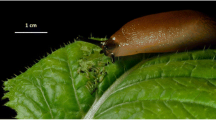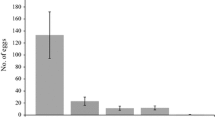Abstract
It is predicted that enemies of insect herbivores may influence the effects of herbivores on their host plants by affecting the choice of plant genotypes. To examine the effect of predators, we conducted two experiments, each with a different caterpillar species (Junonia coenia and Pyrrharctia isabella). Under seminatural conditions, we provided a choice between two genotypes of plantain (Plantago lanceolata) with different levels of iridoid glycosides and used Podisus maculiventris stinkbugs as predators. There were four treatments: no herbivores and no predators, low density of herbivores and no predators, high density of herbivores and no predators, and high density of herbivores plus predators. The caterpillars had little effect on plant growth but did influence the iridoid glycoside concentration. For the Junonia experiment, the concentration of iridoid glycosides was less for plots with a low density of caterpillars (with no predators) compared to the other treatments of caterpillar density. In the Pyrrharctia experiment, catalpol was induced by a high density of caterpillars (with no predators). There were no increases in total iridoid glycosides associated with either herbivore species. The presence of predators had no effect on plant growth or total iridoid glycoside pattern. The lack of effect by predators seems to reflect the relatively large variation in iridoid glycoside concentration among leaf ages, and the herbivores ability to respond to that variation, such that the difference in iridoid glycoside concentrations in the plant genotypes was less important.
Similar content being viewed by others
REFERENCES
Belsky, A. J. 1986. Does herbivory benefit plants? A review of the evidence. Am. Nat. 127:870-892.
Belsky, A. J., Carson, W. P., Jensen, C. L., and Fox, G. A. 1993. Overcompensation by plants: herbivore optimization or red herring? Evol. Ecol. 7:109-121.
Berenbaum, M. R., and Miliczky, E. 1984. Mantids and milkweed bugs: efficacy of aposematic coloration against invertebrate predators. Am. Midl. Nat. 111:64-68.
Bernays, E. A. 1988. Host specificity in phytophagous insects: Selection pressure from generalist predators. Entomol. Exp. Appl. 49:131-140.
Bernays, E. A., and Cornelius, M. L. 1989. Generalist caterpillar prey are more palatable than specialists for the generalist predator Iridomyrmex humilis. Oecologia 79:427-430.
Bobbitt, J. M., and Segebarth, K. P. 1969. Iridoid glycosides and similar substances, pp. 1-145, in W. I. Taylor and A. R. Battersby (eds.). Cyclopentanoid Terpene Derivatives. Dekker, New York.
Bowers, M. D. 1984. Iridoid glycosides and hostplant specificity in larvae of the buckeye butterfly, Junonia coenia (Nymphalidae). J. Chem. Ecol. 10:1567-1577.
Bowers, M. D. 1988. Chemistry and coevolution: iridoid glycosides, plants, and herbivorous insects, pp. 133-166, in K. C. Spencer (ed.). Chemical Mediation of Coevolution. Academic Press, Orlando.
Bowers, M. D. 1992. The evolution of unpalatability and the cost of chemical defense in insects, pp. 216-244, in B. D. Roitberg and M. B. Isman (eds.). Insect Chemical Ecology: An Evolutionary Approach. Chapman and Hall, New York.
Bowers, M. D., and Collinge, S. K. 1992. Fate of iridoid glycosides in different life stages of the buckeye, Junonia coenia (Lepidoptera: Nymphalidae). J. Chem. Ecol. 18:817-831.
Bowers, M. D., and Puttick, G. M. 1988. Response of generalist and specialist insects to qualitative allelochemical variation. J. Chem. Ecol. 14:319-334.
Bowers, M. D., and Puttick, G. M. 1989. Iridoid glycosides and insect feeding preferences: gypsy moths (Lymantria dispar, Lymantriidae) and buckeyes (Junonia coenia, Nymphalidae). Ecol. Entomol. 14:247-256.
Bowers, M. D., and Stamp, N. E. 1992. Chemical variation within and between individuals of Plantago lanceolata (Plantaginaceae). J. Chem. Ecol. 18:989-995.
Bowers, M. D., and Stamp, N. E. 1993. Effects of plant age, genotype, and herbivory on Plantago performance and chemistry. Ecology 74:1778-1791.
Bowers, M. D., and Stamp, N. E. 1997. Fate of host-plant iridoid glycosides in lepidopteran larvae of Nymphalidae and Arctiidae. J. Chem. Ecol. 23:2955-2965.
Bowers, M. D., and Collinge, S. K., Gamble, S. E., and Schmitt, J. 1992. Effects of genotype, habitat, and seasonal variation on iridoid glycoside content of Plantago lanceolata (Plantaginaceae) and the implications for insect herbivores. Oecologia 91:201-207.
Clark, M. S., Luna, J. M., Stone, N. D., and Youngman, R. R. 1994. Generalist predator consumption of armyworm (Lepidoptera: Noctuidae) and effect of predator removal on damage in no-till corn. Environ. Entomol. 23:617-622.
Coley, P. D. 1987. Interspecific variation in plant anti-herbivore properties: the role of habitat quality and rate of disturbance. New Phytol. 106(Suppl.):251-263.
Coley, P. D., Bryant, J. P., and Chapin, F. S. 1985. Resource availability and plant antiherbivore defense. Science 230:895-899.
Darrow, K., and Bowers, M. D. 1999. Effects of herbivore damage and nutrient level on induction of iridoid glycosides in Plantago lanceolata. J. Chem. Ecol.: 25:1427-1440.
Denno, R. F., Larsson, S., and Olmstead, K. L. 1990. Role of enemy-free space and plant quality in host-plant selection by willow beetles. Ecology 71:124-137.
Duff, R. B., Bacon, J. S. D., Mundie, C. M., Famer, V. C., Russell, J. D., and Forrester, A. R. 1965. Catalpol and methylcatalpol: Naturally occurring glycosides in Plantago and Buddleia species. Biochem. J. 96:1-5.
Fajer, E. D., Bowers, M. D., and Bazzaz, F. A. 1992. The effect of nutrients and enriched CO2 environments on production of carbon-based allelochemicals in Plantago: A test of the carbon ?nutrient balance hypothesis. Am. Nat. 140:707-723.
Gardner, D. R., and Stermitz, F. R. 1988. Hostplant utilization and iridoid glycoside sequestration by Euphydryas anicia individuals and populations. J. Chem. Ecol. 14:2147-2168.
Gould, W. P., and Jeanne, R. L. 1984. Polistes wasps (Hymenoptera: Vespidae) as control agents for lepidopterous cabbage pests. Environ. Entomol. 13:150-156.
Heinrich, B. 1979. Foraging strategies of caterpillars: Leaf damage and possible predator avoidance strategies. Oecologia 42:325-337.
Ito, Y., and Higashi, S. 1991. An indirect mutualism between oaks and wood ants via aphids. J. Anim. Ecol. 60:463-470.
Ito, Y., and Miyashita, K. 1968. Biology of Hyphantria cunea Drury (Lepidoptera: Arctiidae) in Japan. V. Preliminary life tables and mortality data in urban areas. Res. Popul. Ecol. 10:177-209.
Jarzomski, C. M., Stamp, N. E., and Bowers, M. D. 2000. Effects of plant phenology, nutrients and herbivory on growth and defensive chemistry of plantain, Plantago lanceolata. Oikos 88:371-379.
Karban, R., and Baldwin, I. T. 1997. Induced Responses to Herbivory. University of Chicago Press, Chicago.
Lopez, J. D., JR, Ridgway, R. L., and Pinnell, R. E. 1976. Comparative efficacy of four insect predators of the bollworm and tobacco budworm. Environ. Entomol. 5:1160-1164.
Mansour, F., Fosen, D., and Shulov, A. 1981. Disturbing effect of a spider on larval aggregations of Spodoptera littoralis. Entomol. Exp. Appl. 29:234-237.
Mukerji, M. K., and Leroux, E. J. 1965. Laboratory rearing of a Quebec strain of the pentatomid predator, Podisus maculiventris (Say) (Hemiptera: Pentatomidae). Phytoprotection 46:40-60.
Nakasuji, F., Yamanaka, H., and Kiritani, K. 1973. Control of the tobacco cutworm Spodoptera litura F. with polyphagous predators and ultra low concentrations of chlorophenamidine. Jpn. J. Appl. Entomol. Zool. 17:171-180 (English summary).
National Climatic Data Center. 1995. Local climatological data: Binghamton, NY. National Oceanic Atmospheric Administration, Asheville, North Carolina.
Paradise, C. J., and Stamp, N. E. 1990. Variable quantities of toxic diet cause different degrees of compensatory and inhibitory responses by juvenile praying mantids. Entomol. Exp. Appl. 55:213-222.
Paradise, C. J., and Stamp, N. E. 1991. Prey recognition time of praying mantids (Dictyoptera: Mantidae) and consequent survivorship of unpalatable prey (Hemiptera: lygaeidae). J. Insect Behav. 4:265-273.
Pollard, A. J. 1992. The importance of deterrence: responses of grazing animals to plant variation, pp. 216-239, in R. S. Fritz and E. L. Simms (eds.). Plant Resistance to Herbivores and Pathogens. University of Chicago Press, Chicago.
Price, P. W., Bouton, C. E., Gross, P., Mcpherson, B. A., Thompson, J. N., and Weis, A. E. 1980. Interactions among three trophic levels: Influence of plants on interactions between herbivores and natural enemies. Annu. Rev. Ecol. Syst. 11:41-65.
Riechert, S. E., and bishop, L. 1990. Prey control by an assemblage of generalist predators: spiders in garden test systems. Ecology 71:1441-1450.
Schultz, J. C. 1992. Factoring natural enemies into plant tissue availability to herbivores, pp. 175-197, in M. D. Hunter, T. Ohgushi and P. W. Price (eds.). Effects of Resource Distribution on Animal-plant Interactions. Academic Press, Orlando.
Scott, J. A. 1986. The butterflies of North America. Stanford University Press, Stanford.
Shapiro, A. M. 1974. Butterflies of the Suisan marsh, California. J. Res. Lepid. 13:191-206.
Simms, E. L., and Triplett, J. 1994. Costs and benefits of plant responses to disease: Resistance and tolerance. Evolution 48:1973-1985.
Stamp, N. E. 1992. Relative susceptibility to predation of two species of caterpillar on plantain. Oecologia 92:124-129.
Stamp, N. E., and Bowers, M. D. 1988. Direct and indirect effects of predatory wasps (Polistes sp.: Vespidae) on gregarious larvae of the buckmoth, Hemileuca lucina (Saturniidae). Oecologia 75:619-624.
Stamp, N. E., and Bowers, M. D. 1991. Indirect effect on survivorship of caterpillars due to presence of invertebrate predators. Oecologia 88:325-330.
Stamp, N. E., and Bowers, M. D. 1992a. Foraging behavior of specialist and generalist caterpillars on plantain (Plantago lanceolata) altered by predatory stinkbugs. Oecologia 92:596-602.
Stamp, N. E., and Bowers, M. D. 1992b. Behavior of specialist and generalist caterpillars on plantain (Plantago lanceolata). Ecol. Entomol. 17:273-279.
Stamp, N. E., and Bowers, M. D. 1993. Presence of predatory wasps and stinkbugs alters foraging behavior of cryptic and non-cryptic caterpillars on plantain (Plantago lanceolata). Oecologia 95:376-384.
Stamp, N. E., and Bowers, M. D. 1994. Effects of cages, plant age and mechanical clipping on plantain chemistry. Oecologia 99:66-71.
Stamp, N. E., and Bowers, M. D. 1996. Consequences for plantain chemistry and growth when herbivores are attacked by predators. Ecology 77:535-549.
Stamp, N. E., and Bowers, M. D. 2000. Foraging behaviour of caterpillars given a choice of plant genotypes in the presence of insect predators. Ecol. Entomol. In press.
Strohmeyer, H. H., Stamp, N. E., Jarzomski, C. M., and Bowers, M. D. 1998. Prey species and prey diet affect growth of invertebrate predators. Ecol. Entomol. 23:68-79.
Tietz, H. M. 1972. An Index to the Described Life Histories, Early Stages and Hosts of the Macrolepidoptera of the Continental United States and Canada, Vol. II, Allyn Museum, Sarasota, Florida.
Tostowaryk, W. 1971. Life history and behavior of Podisus modestus (Hemiptera: Pentatomidae) in boreal forest in Quebec. Can. Entomol. 103:662-673.
Underwood, A. J. 1997. Experiments in ecology. Cambridge University Press, Cambridge.
Van dam, N. M., Van der meijden, E., and Verpoorte, R. 1993. Induced responses in three alkaloid-containing plant species. Oecologia 95:425-430.
Van der meijden, E., Wijn, M., and Verkaar, H. J. 1988. Defence and regrowth, alternative plant strategies in the struggle against herbivores. Oikos 51:355-363.
Whittaker, J. B., and Warrington, S. 1985. An experimental field study of different levels of insect herbivory induced by Formica rufa predation on sycamore (Acer pseudoplatanus) III. Effects on tree growth. J. Appl. Ecol. 22:797-811.
Yamanaka, K., Nakasuji, F., and Kiritani, K. 1972. Life tables of the tobacco cutworm Spodoptera litura (Lepidoptera: Noctuidae) and the evaluation of the effectiveness of natural enemies. Jpn. J. Appl. Entomol. Zool. 16:205-214 (English summary).
Zar, J. H. 1984. Biostatistical Analysis, 2nd ed. Prentice-Hall, Englewood Cliffs, New Jersey.
Author information
Authors and Affiliations
Rights and permissions
About this article
Cite this article
Stamp, N.E., Bowers, M.D. Do Enemies of Herbivores Influence Plant Growth and Chemistry? Evidence from a Seminatural Experiment. J Chem Ecol 26, 2367–2386 (2000). https://doi.org/10.1023/A:1005531028490
Issue Date:
DOI: https://doi.org/10.1023/A:1005531028490




